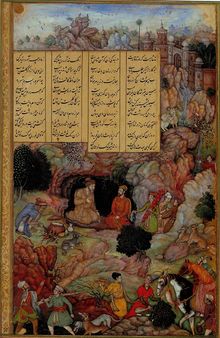Basawan

Basawan (also Basavan , Basavana , Baswan ; * unknown; † after 1600 ) was an Indian miniature painter who worked in the second half of the 16th century . He came from a Hindu family. Initially a student of the Persian master Abd as-Samad at the painting school of the Mughal emperor Akbar I (r. 1556 to 1605), he later rose to become one of the leading artists at Akbar's court. After the death of the painter Daswanth in 1585, he took over the management of the imperial studio. His own date of death is unknown. From around 1600 his name no longer appeared on the marginal inscriptions of Mughal miniatures. Basawan was the father of the miniature painter Manohar .
Basawan created numerous illustrations for Persian manuscripts, but also single sheets. Among his most important early works are miniatures for the known as the "parrot book" Persian collection of stories Tutinama , the adventure novel Hamzanama and the Persian king epic Shahnama associated Darabnama . A clear assignment of individual works to Basawan is often not possible, since at the time of Akbar many miniatures were executed as joint works, for which Basawan mainly made drafts and outline drawings. He reached the peak of his work in the 1580s. His refined late style (including miniatures of the Baburnama and Akbarnama rulers' chronicles ) is characterized by a very precise observation of nature, especially of animals in their natural environment. The later development of Mughal painting under Akbar's successor Jahangir (r. 1605 to 1627) was influenced by his portraits of important historical and contemporary personalities, most of whom he depicted in three-quarter or full profile. Basawan's works appear more plastic and spatial than those of other artists of his time. In this respect, too, they anticipate the more realistic style of the Jahangir period. Influences from European art can be identified, which reached India at the beginning of the second half of the 16th century - that is, before a Portuguese Jesuit mission was sent to Akbar's court in 1580 - mainly in the form of graphics and engravings, and one at the Mughal court received a certain appreciation. European graphics probably served as models for the Folia Basawans for Tutinama , created around 1560 .
source
- Günter Meißner (initial): General artist lexicon (Volume 7: Barbieri - Bayona). KG Saur Verlag, Munich 1993, ISBN 3-598-22747-7 .
Web links
| personal data | |
|---|---|
| SURNAME | Basawan |
| ALTERNATIVE NAMES | Baswan, Basavana |
| BRIEF DESCRIPTION | Indian miniature painter |
| DATE OF BIRTH | 16th Century |
| DATE OF DEATH | after 1600 |